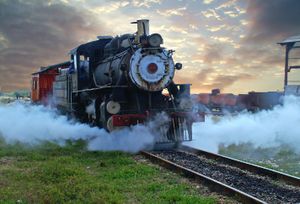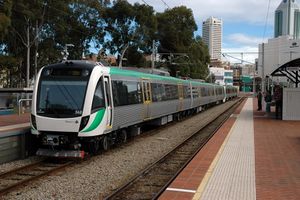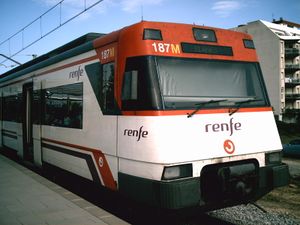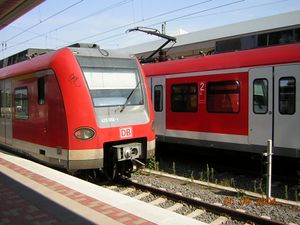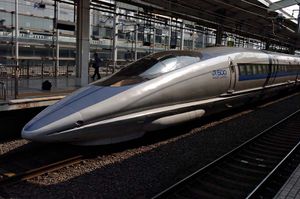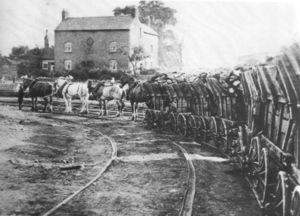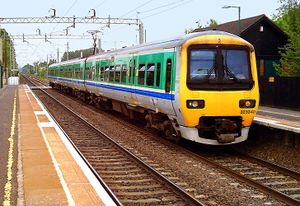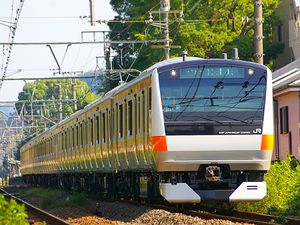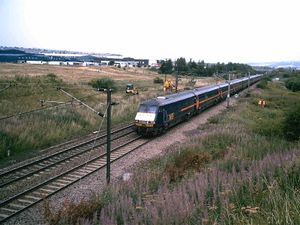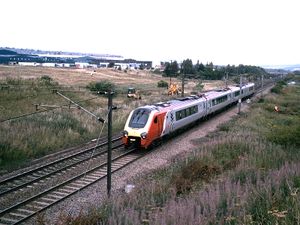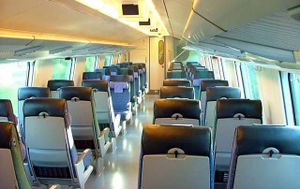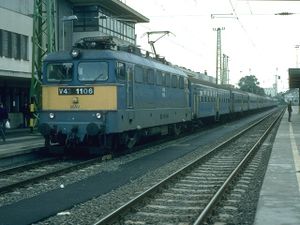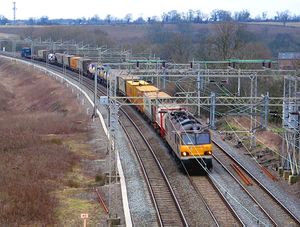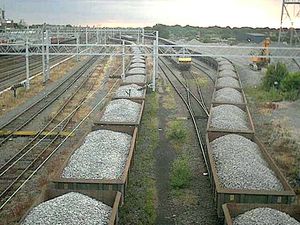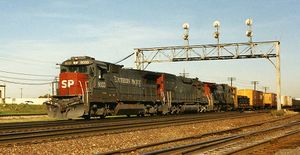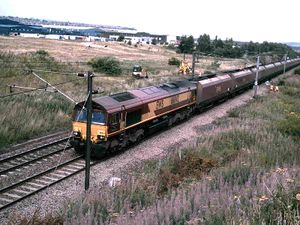Train
In rail transport, a train consists of rail vehicles that move along guides to transport freight or passengers from one place to another. The guideway (permanent way) usually consists of conventional rail tracks, but might also be monorail or maglev. Propulsion for the train is provided by a separate locomotive, or from individual motors in self-propelled multiple units. Most trains are powered by diesel engines or by electricity supplied by trackside systems. Historically the steam engine was the dominant form of locomotive power through the mid-20th century, but other sources of power (such as horses, rope (or wire), gravity, pneumatics, or gas turbines) are possible.
In American railway terminology, the term consist is used to describe the group of rail vehicles which make up a train; similarly, the term trainset refers to a group of rolling stock that is permanently or semi-permanently coupled together to form a unified set of equipment (the term is most often applied to passenger train configurations). In the United Kingdom, the interchangeable terms set and unit are used to refer to a group of permanently or semi-permanently couple vehicles such as those of a multiple unit. While when referring to a train made up of a variety of vehicles, or of several sets/units, the term formation is used. (Although the UK public and media often forgo 'formation', for simply 'train'.)
In the United Kingdom Section 83(1) of the Railways Act 1993 defines "train" as follows:
- a) two or more items of rolling stock coupled together, at least one of which is a locomotive; or
- b) a locomotive not coupled to any other rolling stock.
Similarly, the Atchison, Topeka and Santa Fe Railway's 1948 operating rules define a train as: "An engine or more than one engine coupled, with or without cars, displaying markers."[1]
Contents
Types of trains
There are various types of trains designed for particular purposes.
- Further information: rail transport operations
A train can consist of a combination of one or more locomotives and attached railroad cars, or a self-propelled multiple unit (or occasionally a single powered coach, called a railcar). Trains can also be hauled by horses, pulled by a cable, or run downhill by gravity.
Special kinds of trains running on corresponding special 'railways' are atmospheric railways, monorails, high-speed railways, Dinky Trains, maglev, rubber-tired underground, funicular and cog railways.
A passenger train may consist of one or several locomotives, and one or more coaches. Alternatively, a train may consist entirely of passenger carrying coaches, some or all of which are powered as a "multiple unit". In many parts of the world, particularly Japan and Europe, high-speed rail is utilized extensively for passenger travel.
Freight trains comprise wagons or trucks rather than carriages, though some parcel and mail trains (especially Travelling Post Offices) are outwardly more like passenger trains.
In the United Kingdom, a train hauled by two locomotives is said to be "double-headed", and in Canada and the United States it is quite common for a long freight train to be headed by three, four, or even five locomotives. A train with a locomotive attached at each end is described as 'top and tailed', this practice typically being used when there are no reversing facilities available. Where the second locomotive is attached temporarily to assist a train up steep banks (or down them by providing braking power) it is referred to as 'banking'.
Trains can also be mixed, hauling both passengers and freight, see e.g. Transportation in Mauritania. Such mixed trains became rare in many countries, but were commonplace on the first 19th-century railroads.
Special trains are also used for Track Maintenance; in some places, this is called maintenance of way.
Motive power
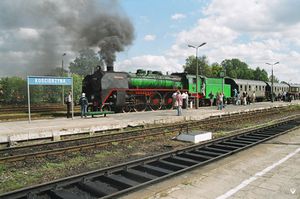
The first trains were rope-hauled, gravity powered or pulled by horses, but from the early 19th century almost all were powered by steam locomotives. From the 1920s onwards they began to be replaced by less labour intensive and cleaner (but more expensive) diesel locomotives and electric locomotives, while at about the same time self-propelled multiple unit vehicles of either power system became much more common in passenger service. Most countries had replaced steam locomotives for day-to-day use by the 1970s. A few countries, most notably the People's Republic of China where coal is in cheap and plentiful supply, still use steam locomotives, but this is being gradually phased out. Historic steam trains still run in many other countries, for the leisure and enthusiast market.
Electric traction offers a lower cost per mile of train operation but at a very high initial cost, which can only be justified on high traffic lines. Since the cost per mile of construction is much higher, electric traction is less favored on long-distance lines. Electric trains receive their current via overhead lines or through a third rail electric system.
Passenger trains
Passenger trains have Passenger cars. Passenger trains travel between stations; the distance between stations may vary from under 1 km to much more. Long-distance trains, sometimes crossing several countries, may have a dining car or restaurant car; they may also have sleeping cars, but not in the case of high-speed rail; these arrive at their destination before the night falls and are in competition with airliners in speed. Very long distance trains such as those on the Trans-Siberian railway are usually not high-speed.
Very fast trains sometimes tilt, like the Pendolino or Talgo. Tilting is a system where the passenger cars automatically lean into curves, reducing the centrifugal forces acting on passengers and permitting higher speeds on curves in the track with greater passenger comfort.
For trains connecting cities, we can distinguish inter-city trains, which do not halt at small stations, and trains that serve all stations, usually known as local trains or "stoppers" (and sometimes an intermediate kind, see also limited-stop).
For shorter distances many cities have networks of commuter trains, serving the city and its suburbs. Some carriages may be laid out to have more standing room than seats, or to facilitate the carrying of prams, cycles or wheelchairs. Some countries have some double-decked passenger trains for use in conurbations. Double deck high speed and sleeper trains are becoming more common in Europe.
Passenger trains usually have emergency brake handles (or a "communication cord") that the public can operate. Abuse is punished by a heavy fine.
Large cities often have a metro system, also called underground, subway or tube. The trains are electrically powered, usually by third rail, and their railroads are separate from other traffic, without level crossings. Usually they run in tunnels in the city center and sometimes on elevated structures in the outer parts of the city. They can accelerate and decelerate faster than heavier, long-distance trains.
A light one- or two-car rail vehicle running through the streets is by convention not considered a train but rather a tram, trolley, light-rail vehicle or streetcar, but the distinction is not always strict. In some countries such as the United Kingdom the distinction between a tramway and a railway is precise and defined in law.
The term light rail is sometimes used for a modern tram, but it may also mean an intermediate form between a tram and a train, similar to metro except that it may have level crossings. These are often protected with crossing gates. They may also be called a trolley.
Maglev trains and monorails represent minor technologies in the train field.
The term rapid transit is used for public transport such as commuter trains, metro and light rail. However, in New York City, lines on the New York City Subway have been referred to as "trains".
Some commuter trains in Tokyo, Japan have special cars which the bench seats fold up to provide standing room only during the morning rush hour (until 10 a.m.). The E231 series train has two of these cars in each set (Usually 10 or 11cars per set), officially nicknamed "roku-tobira-sha" (literally, "6 door car") - all the other cars have four sets of doors on each side.
An estimated 3.5 million passengers ride every day on Tokyo's Yamanote Line, with its 29 stations. For comparison, the New York City Subway carries 4.8 million passengers per day on 26 lines serving 468 stations.
Freight trains
Freight trains have freight cars. Much of the world's freight is transported by train. In the USA the rail system is used mostly for transporting cargo (or freight).
Under the right circumstances, transporting freight by train is highly economic, and also more energy efficient than transporting freight by road. Rail freight is most economic when freight is being carried in bulk and over long distances, but is less suited to short distances and small loads. Bulk aggregate movements of a mere twenty miles can be cost effective even allowing for trans-shipment costs. These trans-shipment costs dominate in many cases and many modern practices such as container freight are aimed at minimizing these.
The main disadvantage of rail freight is its lack of flexibility. For this reason, rail has lost much of the freight business to road competition. Many governments are now trying to encourage more freight onto trains, because of the environmental benefits that it would bring.
There are many different types of freight trains, which are used to carry many different kinds of freight, with many different types of wagons. One of the most common types on modern railways are container trains, where containers can be lifted on and off the train by cranes and loaded off or onto trucks or ships.
This type of freight train has largely superseded the traditional boxcar type of freight train, with which the cargo has to be loaded or unloaded manually.
In some countries "piggy-back" trains are used: trucks can drive straight onto the train and drive off again when the end destination is reached. A system like this is used on the Channel Tunnel between England and France and between France and Italy (Modalohr road trailer carriers). Piggy back trains are the fastest growing type of freight trains in the United States, where they are also known as 'trailer on flatcar' or TOFC trains. There are also some "inter-modal" vehicles, which have two sets of wheels, for use in a train, or as the semi-trailer of a road vehicle. This is obsolete, the current semi-trailers have road wheels only and are carried on specially adapted trucks when moving on rails, for specific details see Roadrailer.
There are also many other types of wagons, such as "low loader" wagons for transporting road vehicles. There are refrigerator cars for transporting foods such as ice cream. There are simple types of open-topped wagons for transporting minerals and bulk material such as coal, and tankers for transporting liquids and gases. Today however most coal and aggregates are moved in hopper wagons that can be filled and discharged rapidly, to enable efficient handling of the materials.
Freight trains are sometimes illegally boarded by passengers who do not wish, or do not have the money, to travel by ordinary means. This is referred to as "hopping" and is considered by some communities to be a viable form of transport. Most hoppers sneak into train yards and stow away in boxcars. More bold hoppers will catch a train "on the fly", that is, as it is moving, leading to occasional fatalities.
Famous train routes
Famous historical train services include the:
- Orange Blossom Special - New York, NY to Miami, FL.
- Orient Express in Europe.
- Super Chief - Chicago, IL to Los Angeles, CA.
- Trans-Siberian in Russia.
- Bernina Express from Davos, Switzerland to Tirano, the highest railway transversal in the alps.
- Blue Train in South Africa.
- Train-de-Luxe from Johannesburg to Victoria Falls.
- Chihuahua al Pacifico in Mexico.
- Glacier Express from St. Moritz to Zermatt in Switzerland.
- Palace on Wheels in Rajasthan, India.
- Frontier Mail and Grand Trunk Express, India.
- Broadway Limited New York, NY to Chicago, IL.
- The Canadian in Canada.
- 20th Century Limited New York, NY to Chicago, IL.
- City of New Orleans Chicago, IL to New Orleans, LA.
- California Zephyr Chicago, IL to San Francisco, CA.
- Indian Pacific and The Ghan in Australia (long-distance rail).
- Puffing Billy and The Gulflander in Australia (heritage and touring).
- Rheingold Express in The Netherlands, Germany and Switzerland, following the course of the Rhine.
- Deccan Queen Mumbai to Pune, India.
- Flying Scotsman, London to Edinburgh, in the United Kingdom.
- Alberta Prairie Railway Excursions, Stettler, Alberta, to Big Valley, Alberta, Canada.
Fictional trains
- Thomas the Tank Engine and Friends — TV Series originated from The Railway Series by the Rev.W.Awdry
- The Polar Express — From the book of the same name, this train takes children to the North Pole.
- Silver Streak Appeared in two movies, the 1934 thriller Silver Streak and the 1976 comedy with Gene Wilder and Richard Pryor.
- Taggart Comet (Atlas Shrugged)
- The Great Train Robbery — feature film based on a true story, also title of a modern film.
- Starlight Express (Andrew Lloyd Webber) — Musical about an old steam engine being replaced by an electrical engine.
- Galaxy Express 999 — From the manga and anime of the same name by Leiji Matsumoto, this train travels the galaxy from planet to planet.
- Runaway Train — Film about escaped inmates on a runaway train.
- Atomic Train — TV movie (1999) A runaway train carrying an atomic bomb into a town.
- Astrotrain A Decepticon triple-changer from the Transformers More Than Meets the Eye character line.
- Supertrain — One of the biggest television disasters ever.
- "The Celestial Railroad" — Short story by Nathaniel Hawthorne
- The Taking of Pelham 123 — 1974 film adapted from the John Godey novel of the same name about the hijacking of a New York Subway train.
- Hogwarts Express: Harry Potter book series
- See also: Rail transport in fiction and List of films featuring trains
External links: List of Railway Movies (as of December 5, 1994).
See also
| Rail transport |
|---|
| Operations |
| Stations |
| Trains |
| Locomotives |
| Rolling stock |
| History |
| Terminology |
| By country |
| Disasters |
|
|
| Wikimedia Commons has media related to: Train |
- Amtrak
- Armoured train
- British Rail
- Cab car
- Coach (rail)
- Control car
- Coupling
- Deutsche Bahn
- Dome car
- Double decker train
- Gyro Monorail
- List of rail accidents
- List of railway companies
- Low-floor trains
- Monorail
- Passenger train human waste disposal
- People mover
- Push-pull train
- Rail transport modelling
- Railway post office
- Tilting train
- Toy train
- Train whistle
- Train wreck
- Tram
- Travelling Post Office
- Turbotrain
- Turbo (train)
- Unit train
- VIA Rail
- Hybrid Train
References
- ↑ Atchison, Topeka and Santa Fe Railway (1948). Rules: Operating Department, p 7.
Further reading
- Jonathan Glancey - The Train (2004)
External links
- High Speed Train
- Official train times in the UK (from National Rail).
- On-Track-On-Line.com - Discussion of train travel and various aspects of the railroading hobbies.
- Trainfoamers.com - It's Free To Talk Trains Again!
- RailServe.com: The Internet Railroad Directory - directory of 10,000+ rail-related sites
- Railroad Forums - Discussion forum on trains from around the world
- Trainorders.com - Focus on trains of North America
- Royal Engineers Museum - Transportation
- Fotocomboio.com - Portuguese trains
- List of railroad car manufacturers by country (in French)
- TimeTable MicroEdition Open-source train schedule/timetable for PDA and handheld devices
- Historic Trains Quality collection of old train photographs
- Cafe le Wagon One of the greatest stream-engine train museums. In Selçuk/İzmir
